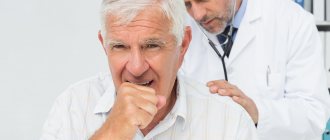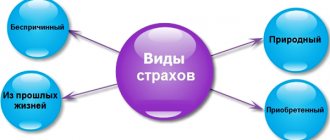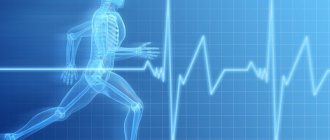Pain in the limbs and back
Neurosis is characterized by pain in the lower back and limbs. The symptom is similar to lumbosacral radiculitis, but the discomfort is not localized in one clearly defined area.
Pain in the back may occur due to a minor injury. With neurosis, damage takes a very long time to recover. Pain syndrome can also be caused by excessive suspiciousness of a neurotic person. For example, a person communicates with a patient suffering from osteochondrosis or radiculitis and immediately finds all the symptoms of the disease and feels pain.
Pain in the arms and legs during neurosis is associated with mental symptoms:
- irritability;
- weakness;
- great fatigue;
- disturbances in sleep and wakefulness;
- decreased libido;
- lack of appetite;
- increased suspiciousness.
Typically, patients suffering from limb neuroses are easily suggestible. They have low self-esteem. Under the influence of the syndrome, the individual becomes irritable and constantly angry.
Pain due to neurosis in the back and legs
Pain due to neurosis is noted in the back and legs, which in turn at first glance is very similar to lumbosacral radiculitis. However, a distinctive feature of pain in neurosis will be the lack of clear localization. If the local painful point is in the leg, then in addition to pain, some tingling, numbness or a pins and needles sensation may be felt. There is a decrease or, conversely, a clear increase in sensitivity.
Back pain due to neurosis can appear with the slightest injury to the spine and last for quite a long time. In addition, due to strong suggestibility, a person suffering from neurosis may experience pain in the back and legs even without any external influences. For example, after talking with a patient with radiculitis, he “discovers” exactly the same signs of the disease.
Headache
With neurosis, headaches can be permanent or appear only at the time of an emotional outburst. What kind of pain is observed during neurosis:
- feeling of pressure, constriction;
- pulling sensations;
- pulsation.
The aching or stabbing sensation does not go away for a long time. The scalp responds sharply to touch with pain or does not react at all. This is how neuromuscular migraine headaches manifest themselves. It is called tension headache.
The pain syndrome often causes dizziness, weakness, nausea and even vomiting.
The pain point can be located in any part of the head or cervical spine. The occurrence of pain is always associated with increased anxiety and fear. In case of neurosis, the cause of migraine may be hypothermia.
Neurovascular pain manifests itself as pulsation. Is permanent. It is most often localized in the temporal lobes. Nausea and dizziness are rare.
Pain all over the body
With neurosis, patients often complain of unpleasant sensations in the body. Cases of skin syndrome are common. The epidermis itches and burns. Becomes pale with cyanosis. This manifestation is accompanied by special symptoms.
- Change in sensitivity.
- Deterioration of mobility, which provokes stiffness of the lower extremities, legs hurt and drag.
- Dry skin or increased oiliness.
- Hallucinations of a tactile nature.
Muscle neuroses are easily confused with a somatic disease. Pathology is provoked by intense physical work aimed at one muscle group.
What hurts with neurosis:
- thoracic region;
- neck area;
- upper, lower limbs;
- back.
Neurosis of the facial nerve often occurs. Painful sensations are accompanied by tingling and numbness. The burning sensation can spread throughout the body or be localized only in the legs. Symptoms of muscle neurosis are manifested by tissue spasms, convulsive contractions, and prolonged hypertonicity.
Eye pain
Eye soreness during neurosis causes a narrowing of the field of vision, partial or complete loss of vision. A characteristic feature is the preservation of spatial orientation. Even with complete blindness, patients do not bump into pieces of furniture. A detailed study reveals the preservation of the reaction to light.
Visual impairment is under the direct influence of an irritating factor. Loss of visibility occurs instantly. The body tries to protect itself by literally trying not to look at the threat.
Visual neurosis is more often observed in women. The reaction of such patients to the problem is interesting. They completely calmly accept the fact of vision loss. When examined, no physical causes for blindness are found. The symptom is characteristic of the hysterical form of neurosis.
How eyes hurt during neurosis:
- sharp nagging pain;
- discomfort inside the cornea.
The eyeballs contain a huge number of nerve endings and pain receptors. When you are overtired or stare for a long time, the receptors transmit the pain impulse directly to the brain.
How to deal with headaches
Headache is a constant companion of a nervous disorder, manifesting itself in all patients. Cephalgia significantly reduces the quality of life, making it practically incapacitating. It is important not only to learn how to relieve a headache, but also to calm yourself down during the peak of nervous tension. Only after complete recovery will the unpleasant sensations disappear completely.
How to relieve headaches due to neurosis:
- take a painkiller along with a sedative;
- retire;
- massage your temples;
- breathe calmly, measuredly;
- try to transfer all your attention to the breathing rhythm;
- from the temples smoothly move to the back of the head;
- then, running your hands through your hair, pull it up a little.
Tranquilizers, acting on the nervous system, inhibit its activity. They have a relaxing, anticonvulsant, antiemetic effect. Strong drugs have a pronounced hypnotic effect. Application is indicated for a period of 7 days.
Antidepressants help normalize the amount of neurotransmitters in the brain. The effect is observed from 7-14 days of administration. Under the influence of the drugs, patients' mood improves, fears and feelings of powerlessness go away. Gradually the patient regains strength, and pain appears much less frequently.
Constant pain relief with any painkillers, tranquilizers, or treatment with antidepressants will not give a positive effect without a psychological restructuring. It is important for patients to master relaxation techniques that will help them remain calm even in a stalemate.
How to deal with body pain
To relieve pain, it is necessary to restore the neurotransmitter connection between peripheral receptors located on the body and the receptors of the central nervous system. Under the skin of a person there is a huge number of nerve endings. Through mechanical action on them, it is possible to transmit a signal to the brain to relax a certain part of the body. The transmission of ion impulses accelerates blood flow and tissue regeneration. By launching metabolic processes, the body accelerates the flow of lymph, which allows you to quickly eliminate stagnant processes and restore the previous state of the diseased organ.
Joint pain due to neurosis can be relieved with water treatments. Take a relaxing bath with chamomile, lavender or lemon balm. Rub in body cream and lie down to rest. Only painkillers will help quickly.
Such sensations can also be eliminated through psychocorrection. By establishing a verbal or contact anchor, you can control pain at any time. The method is based on self-hypnosis. Requires a lengthy process of installation and learning to use.
What is neurosis
Neurosis is a functional mental disorder that usually arises as a result of internal and external conflicts. The disease lasts a long time and leads to changes in a person’s mental abilities and physical condition. The main feature of neurosis, which distinguishes it from other mental illnesses, is the preservation of an adequate perception of reality. The person is aware of his problems and is ready to be treated.
Neurosis is a mental disorder that prevents the body from adapting to environmental conditions. In severe cases, a person perceives reality in a distorted form. This causes the development of serious mental and nervous system diseases.
Causes of neurosis
Neurosis occurs for various reasons. This is usually due to hidden conflicts. They can be personal (internal), interpersonal, family. Various factors and situations have a short-term or long-term impact on the human psyche.
- diffidence;
- inability to think rationally;
- apathy;
- dissatisfaction with the current situation;
- pressure from others.
- long-term crisis (failures at work, problems communicating with friends, in love relationships, etc.);
- dissatisfaction in relationships;
- dependence on another person - on parents, spouse, etc.;
- inflated demands of society.
- betrayal of a loved one;
- breakup of love relationships;
- quarrels and scandals in the family;
- suppression of personality by a loved one, struggle for leadership;
- lack of attention, understanding, care, affection and love in the family;
- psychosexual disharmony of spouses;
- poor financial situation.
Also, the causes of a nervous breakdown, which can lead to the development of neurosis, can be: the death of a loved one, chronic stress, past illnesses and psychological trauma, frequent overload of the nervous system and physical activity. Some doctors believe that the cause of the basic conflict in neurosis is the contradiction between incompatible personality defense mechanisms that are formed in childhood. These are ways of responding to various social factors.
Causes of neurosis
The main cause of neurosis is a psychotraumatic factor or a psychotraumatic situation. In the first case, the negative impact is short-term, for example, the loss of a loved one. In the second - long-term, for example, family conflict. The main role in the occurrence of neurosis is played by traumatic situations, most often intra-family conflicts.
The inability to productively resolve a conflict to one degree or another can lead to personality disorganization, which in turn manifests itself in mental and physical symptoms.
Psychotraumatic factors and situations include:
Family and household conflicts.
- Cheating and separation;
- Frequent conflicts, scandals;
- Excessive strictness in education or vice versa – pampering;
- Pathological jealousy;
- Pronounced suppression and leadership;
- Ambition of parents.
Interpersonal conflicts.
They can occur between family members or be non-family (for example, at work). In interpersonal conflict, the needs of two people contradict, disorganizing mental activity and leading to constant tension. It is these conflicts that in 35% of cases lead to the obvious development of neurosis.
Intrapersonal conflicts.
In this conflict, a person’s desires, his own needs and emotions contradict. With this conflict, when desires do not coincide with possibilities, psycho-emotional distress is generated, which underlies neurosis. Intrapersonal conflicts lead to the development of neuroses in men, namely in 45% of cases.
Symptoms of neurosis
Symptoms of neurosis are divided into two groups: mental and physical. A sick person does not always exhibit both types of symptoms. This can make it difficult to make an immediate diagnosis. Individually, mental and physical signs can be symptoms of other diseases and disorders.
Mental symptoms appear in neurosis more often than physical ones. These include:
- emotional instability;
- sudden mood swings, irritability;
- indifference;
- isolation;
- anxiety;
- sensitivity to stress;
- unreasonable feeling of fear;
- panic attacks;
- touchiness.
With neurosis, memory may deteriorate and thinking abilities may decrease: people become inattentive, confused, and get tired quickly. They are often bothered by insomnia.
Because of this, they become irritable and aggressive. Patients with neurosis observed: low or high self-esteem, changes in life values, the appearance of phobias and a reluctance to communicate with people around them, even with loved ones.
Physical symptoms of neurosis are manifested by disruption of the autonomic system and pain in different parts of the body. Vegetative symptoms appear on the body and in individual body systems, but do not cause pathologies. These include:
- decreased or increased blood pressure, resulting in dizziness and dark vision;
- headaches, pain in the temporal region;
- skin rashes, redness, itching;
- allergic reactions without exposure to an allergen - rash on the face or body, edema syndrome;
- increased sweating, rapid heartbeat;
- disruption of the stomach and intestines and, as a result, problems with stool;
- rapid or difficult breathing, feeling of a lump in the throat;
- frequent urination.
Bodily symptoms are manifested by pain in the body. Typically, pain is not felt in a specific place, as with an organic disorder of the nervous system. With neurosis, painful and unpleasant sensations alternately appear in different parts of the body and then disappear. This phenomenon depends on the psycho-emotional state of a person.
In people suffering from neurosis, performance decreases, the functioning of the vestibular apparatus is disrupted, sexual desire decreases, and sometimes completely disappears. Sometimes problems with appetite arise - either a constant feeling of hunger or lack of appetite.
Often, patients experience phantom pain due to experiences caused by fear or anxiety about their health or something else. Problems with sleep appear - neurotic people find it difficult to fall asleep. They often wake up at night, have nightmares, and even after a long rest feel tired.
Neurotic pain in legs and arms
Mental disorders, such as neurosis, not only affect a person’s emotional state, but also manifest themselves at the physical level. Pain in the arms and legs with neurosis is a common phenomenon. These symptoms require complex treatment.
What is neurosis
Neurosis is a functional mental disorder that usually arises as a result of internal and external conflicts.
The disease lasts a long time and leads to changes in a person’s mental abilities and physical condition.
a feature of neurosis that distinguishes it from other mental illnesses is the preservation of an adequate perception of reality. The person is aware of his problems and is ready to be treated.
Neurosis is a mental disorder that prevents the body from adapting to environmental conditions. In severe cases, a person perceives reality in a distorted form. This causes the development of serious mental and nervous system diseases.
Causes of neurosis
Neurosis occurs for various reasons. This is usually due to hidden conflicts. They can be personal (internal), interpersonal, family. Various factors and situations have a short-term or long-term impact on the human psyche.
Internal conflicts:
- diffidence;
- inability to think rationally;
- apathy;
- dissatisfaction with the current situation;
- pressure from others.
Interpersonal conflicts:
- long-term crisis (failures at work, problems communicating with friends, in love relationships, etc.);
- dissatisfaction in relationships;
- dependence on another person - on parents, spouse, etc.;
- inflated demands of society.
Family conflicts:
- betrayal of a loved one;
- breakup of love relationships;
- quarrels and scandals in the family;
- suppression of personality by a loved one, struggle for leadership;
- lack of attention, understanding, care, affection and love in the family;
- psychosexual disharmony of spouses;
- poor financial situation.
Also, the causes of a nervous breakdown, which can lead to the development of neurosis, can be: the death of a loved one, chronic stress, past illnesses and psychological trauma, frequent overload of the nervous system and physical activity. Some doctors believe that the cause of the basic conflict in neurosis is the contradiction between incompatible personality defense mechanisms that are formed in childhood. These are ways of responding to various social factors.
Symptoms of neurosis
Symptoms of neurosis are divided into two groups: mental and physical. A sick person does not always exhibit both types of symptoms. This can make it difficult to make an immediate diagnosis. Individually, mental and physical signs can be symptoms of other diseases and disorders.
Mental symptoms
Mental symptoms appear in neurosis more often than physical ones. These include:
- emotional instability;
- sudden mood swings, irritability;
- indifference;
- isolation;
- anxiety;
- sensitivity to stress;
- unreasonable feeling of fear;
- panic attacks;
- touchiness.
With neurosis, memory may deteriorate and thinking abilities may decrease: people become inattentive, confused, and get tired quickly. They are often bothered by insomnia.
Because of this, they become irritable and aggressive. Patients with neurosis observed: low or high self-esteem, changes in life values, the appearance of phobias and a reluctance to communicate with people around them, even with loved ones.
Physical signs
Physical symptoms of neurosis are manifested by disruption of the autonomic system and pain in different parts of the body. Vegetative symptoms appear on the body and in individual body systems, but do not cause pathologies. These include:
- decreased or increased blood pressure, resulting in dizziness and dark vision;
- headaches, pain in the temporal region;
- skin rashes, redness, itching;
- allergic reactions without exposure to an allergen - rash on the face or body, edema syndrome;
- increased sweating, rapid heartbeat;
- disruption of the stomach and intestines and, as a result, problems with stool;
- rapid or difficult breathing, feeling of a lump in the throat;
- frequent urination.
Bodily symptoms are manifested by pain in the body. Typically, pain is not felt in a specific place, as with an organic disorder of the nervous system. With neurosis, painful and unpleasant sensations alternately appear in different parts of the body and then disappear. This phenomenon depends on the psycho-emotional state of a person.
In people suffering from neurosis, performance decreases, the functioning of the vestibular apparatus is disrupted, sexual desire decreases, and sometimes completely disappears. Sometimes problems with appetite arise - either a constant feeling of hunger or lack of appetite.
Often, patients experience phantom pain due to experiences caused by fear or anxiety about their health or something else. Problems with sleep appear - neurotic people find it difficult to fall asleep. They often wake up at night, have nightmares, and even after a long rest feel tired.
Pain due to neurosis
In addition to general malaise, with neurosis a person experiences pain in different parts of the body - arms, legs, back, heart, stomach, headaches, etc. Often these pains are perceived as physical diseases associated with disruption of the functioning of individual systems and internal organs.
An erroneous diagnosis is made not through the fault of doctors, but because many symptoms of neurosis coincide with signs of physical diseases. In such cases, it is advisable to consult a psychotherapist. However, pain may not mean the presence of neurosis at all, but may be a sign that precedes it.
Pain in the body and individual organs causes not only discomfort on the physical level, but also discomfort on the psychological and emotional levels. Sometimes it can be difficult to determine which parts of the body hurt. This is associated with wandering pain.
It occurs as a result of an imbalance in the autonomic system, which leads to malfunctions of organs. Due to wandering pain, when examining specific organs in which pain is present, pathology is not detected. In this case, the problem must be sought in the functioning of the nervous system.
Pain in legs and arms
Neurosis often provokes the development of vegetative-vascular dystonia, which causes headaches, pain in the heart, muscles and joints. Some people with neurotic disorder complain of back pain, which is misdiagnosed as sciatica, lumbar hernia, or vertebral misalignment. But more often pain appears in the legs or arms.
Their main difference from the usual pain, which signals physical malfunctions in the body, is the presence of other accompanying sensations, such as tingling, numbness, swelling, changes in skin color, changes in the sensitivity of the limbs, etc.
Due to severe anxiety and self-hypnosis, pain in the joints and muscles occurs without the influence of external factors and injuries. Sometimes a neurotically ill person, after communicating with people who have real physical illnesses, begins to experience the same symptoms as them, which develop into real pain.
In stressful situations or depression, pain in the arms and legs worsens, since it directly depends on the person’s mental state. During a period of peace and tranquility, the pain decreases or disappears altogether, and at a moment of slight excitement it appears again, sometimes with an increased pain threshold.
Therapy for neurotic pain
In addition to emotional and psychological factors, physical overload and sedentary work requiring the same type of actions can provoke the appearance of neurotic pain in organs, muscles and joints.
Treatment must be comprehensive.
It is selected individually and includes the use of special medications to help relieve stress, fatigue and other mental and physical symptoms, as well as psychotherapy sessions.
Sometimes, in parallel with psychotherapy, patients are prescribed physiotherapeutic procedures. In some cases, a change in daily routine, diet and diet is required. Therapeutic exercises are recommended.
Pain due to neurosis
In addition to general malaise, with neurosis a person experiences pain in different parts of the body - arms, legs, back, heart, stomach, headaches, etc. Often these pains are perceived as physical diseases associated with disruption of the functioning of individual systems and internal organs.
An erroneous diagnosis is made not through the fault of doctors, but because many symptoms of neurosis coincide with signs of physical diseases. In such cases, it is advisable to consult a psychotherapist. However, pain may not mean the presence of neurosis at all, but may be a sign that precedes it.
Pain in the body and individual organs causes not only discomfort on the physical level, but also discomfort on the psychological and emotional levels. Sometimes it can be difficult to determine which parts of the body hurt. This is associated with wandering pain.
It occurs as a result of an imbalance in the autonomic system, which leads to malfunctions of organs. Due to wandering pain, when examining specific organs in which pain is present, pathology is not detected. In this case, the problem must be sought in the functioning of the nervous system.
Neurosis often provokes the development of vegetative-vascular dystonia, which causes headaches, pain in the heart, muscles and joints. Some people with neurotic disorder complain of back pain, which is misdiagnosed as sciatica, lumbar hernia, or vertebral misalignment. But more often pain appears in the legs or arms.
Their main difference from the usual pain, which signals physical malfunctions in the body, is the presence of other accompanying sensations, such as tingling, numbness, swelling, changes in skin color, changes in the sensitivity of the limbs, etc.
Due to severe anxiety and self-hypnosis, pain in the joints and muscles occurs without the influence of external factors and injuries. Sometimes a neurotically ill person, after communicating with people who have real physical illnesses, begins to experience the same symptoms as them, which develop into real pain.
In stressful situations or depression, pain in the arms and legs worsens, since it directly depends on the person’s mental state. During a period of peace and tranquility, the pain decreases or disappears altogether, and at a moment of slight excitement it appears again, sometimes with an increased pain threshold.
In addition to emotional and psychological factors, physical overload and sedentary work requiring the same type of actions can provoke the appearance of neurotic pain in organs, muscles and joints. Treatment must be comprehensive. It is selected individually and includes the use of special medications to help relieve stress, fatigue and other mental and physical symptoms, as well as psychotherapy sessions.
Sometimes, in parallel with psychotherapy, patients are prescribed physiotherapeutic procedures. In some cases, a change in daily routine, diet and diet is required. Therapeutic exercises are recommended.
In order to prevent the appearance of neurosis, you need to lead a correct lifestyle - get rid of bad habits, play sports, observe a work and rest schedule. Sleep should be complete. Eat more vitamins and less junk food high in calories and cholesterol. Be in the fresh air more often, do physical exercises - whatever you can do.
It is useful to learn to control your emotions. Calm music will help you relax. Avoid stressful situations and try not to take problems too emotionally.
Neurosis is a mental disorder that manifests itself not only at the psycho-emotional level, but also affects the physical condition of a person. Often with neuroses, pain occurs in different organs and parts of the body.
Pain in the arms and legs is neuropathic, because it depends on the psycho-emotional state of the patient. To get rid of such pain, it is necessary to undergo complex treatment, including medication and psychotherapy.
Muscular neurosis is a pathological process in which there is depletion of the nervous system. With the disease, not only the patient’s nervousness is noted, but also muscle strain. This negatively affects the patient’s quality of life and requires emergency treatment.
How best to relieve muscle tension during neurosis: tips – Depressed
In order to understand how to relieve muscle tension during neurosis, you need to understand what kind of disease it is. Neurosis is a disease that occurs due to a disorder of the central nervous system.
Why do muscles tense up during neurosis?
A person under stress experiences anxiety, rapid heartbeat, and fear; Against this background, muscle tension may occur. For example, in case of danger, muscle tone and contractility increase. This causes an increase in the speed of muscle work and increases the physical strength of a person.
Neurosis can cause cramps and constant tension in the body if fatigue and irritability are not reduced. Intramuscular nerves may become pinched as a result of muscle stiffness.
How to relieve muscle tension during neurosis
An increase in muscle tone can manifest itself as stiffness of one or more muscles (when it is completely impossible to relax it) or as weakness, muscle hypotonia.
The applied therapy for the treatment of these phenomena:
- Soft, gentle massage.
- Warm bath with essential oils.
- Swimming in the pool.
- Cold and hot shower.
- Acupuncture should be performed by experienced doctors. It is not recommended to do it yourself.
When a person relaxes, muscle stiffness will decrease.
Drug treatment
Drug treatment should be carried out if methods without the use of drugs have not brought results. Treatment is carried out exclusively with the help of specialists. The drugs have a strong effect on the central nervous system; precise dosage must be observed.
Drug treatment may be prescribed if muscle twitching occurs, which occurs due to disruption of the nervous system. For neuroses the following may be prescribed:
- Sedatives (infusion of valerian, motherwort or peony).
- Tranquilizers. They are prescribed for the presence of phobias and fears. Nausea and drowsiness may occur while using these medications. Exceeding the dose is prohibited, as this leads to general weakness of the body.
- Antidepressants. They are sold strictly according to a doctor's prescription and relieve stress and anxiety.
- Multivitamin complexes.
- Neuroleptics (antipsychotics).
Psychotherapeutic techniques
There are several psychotherapeutic methods. Cognitive behavioral therapy may be used to help understand the causes of stress reactions.
Adaptability therapy is also used, during which the patient adapts to stress, which leads to relief from neurosis.
Through meditation, the patient can get rid of fears.
Hypnotherapy will give positive results.
Lack of sunlight can provoke muscle neurosis in people working indoors. Light therapy is used for treatment.
Physiotherapy
Physiotherapy is based on the use of such factors:
- cold and heat;
- water and ultraviolet radiation;
- electric current and magnetic field.
To carry out the procedures, use:
- Darsonvalization.
- Electrical stimulation.
- Electrophoresis.
- Electrosleep.
- Sharko's shower.
- Hydromassage.
- Circular shower.
Physiotherapy will help:
- eliminate muscle spasm;
- remove cramps;
- strengthen blood vessels;
- numb.
Effective treatment results with this method appear after 4-5 procedures.
Massage
For neuroses, massage is useful because of its calming properties. Soreness also decreases, muscle pain gradually recedes. Recommended massage:
- faces;
- collar area;
- backs;
- lower extremities;
- chest;
- belly;
- hands
Acupressure will also be useful.
When massaging, strong pressure is contraindicated. With proper massage, patients get rid of headaches, tinnitus, and dizziness.
Exercises
People who suffer from muscle stiffness are recommended to do exercises 2-3 times a week. Before starting exercises, you need to do a warm-up. Repeat each action 5-10 times:
- Standing straight, tense your arm, then relax the muscle and lower your arm. Repeat with the other arm, legs, neck.
- Raise your shoulders, then lower them and pull them back.
- Standing on all fours, bend your back, then bend upward as much as possible.
- Sitting on a chair, stretch your legs parallel to the floor. Hold this position and then place your feet on the floor.
- With your feet slightly turned inward, bend over and touch the floor with your hands.
In addition to exercise, yoga and physical therapy classes are beneficial.
Dear readers! We strongly recommend that you consult a doctor before taking medications or self-medicating. There are contraindications.
Source:
How to relieve symptoms of muscle tension due to neurosis
Daily psycho-emotional stress, as well as stress, negatively affects people’s well-being. They can provoke various internal diseases. Therefore, every person needs to know how to relieve muscle tension during neuroses. There are many methods - the doctor will tell you the best options after the examination.
Causes
Each of the neuroses that arise in a person is a consequence of a high concentration of stress hormones, which are produced in the human body as a response to external aggression.
Nature provides such a mechanism only for real danger - the threat of physical violence.
Meanwhile, the modern rhythm of life is accompanied by constant tension in the body due to moral dangers - intellectual overload, holding grievances against people around us.
The stress hormone does not have time to be completely utilized, and nervous spasms appear:
- the brain receives a signal about a threat from the outside;
- it is necessary to prepare the body to repel an attack - imaginary or real;
- the hormonal glands receive a command to increase the need for biological active substances;
- a new portion of stress hormones enters the bloodstream;
- the muscles become toned - for the fight.
When faced with daily moral overload, stress disorders, or monotonous, monotonous work, tension in the abdominal or shoulder girdle muscles leads to a deterioration in well-being. The problem becomes widespread and requires medical intervention.
Symptoms
With nervous tension, symptoms do not appear immediately - signs of muscle neurosis appear in response to a chronic, prolonged stay in a state of stress.
At the beginning, people notice periodic, local tingling in a certain part of the body, or numbness in it. With this “bell”, muscle overstrain makes itself known.
With timely provision of medical assistance, it is possible to quickly cope with such a health disorder.
If the psychological state does not improve - the situation remains emotionally unstable and difficult for a person, then emotional tension is transformed into muscle tension. Its symptoms:
- myofascial pain – a person accurately indicates the most problematic area;
- burning with tingling gradually increases in intensity of manifestations;
- the level of anxiety and nervous excitability increases;
- when the neck muscles are overstrained, headaches appear - diffuse, dull;
- various problems with sleep appear - with falling asleep, or intermittency, as well as a feeling of weakness in the body in the morning;
- if the facial muscles become tense, then facial expressions are distorted - involuntary twitching of its different parts;
- on the part of the cardiovascular system, manifestations will be in the form of tachycardia or cardialgia - pain in the heart muscle when muscles tense in the diaphragm area.
In a severe mental state, tension in the head with neurosis alone does not end the matter - convulsions and epilepsy form. Treatment tactics will require a comprehensive and long-term approach.
How to relieve muscle spasm
There are many recommendations and useful tips to relieve nervous tension in the muscles. Most of them are based on a reflex change in the nerve innervation of muscle fibers.
So, if possible, it is better to completely stop communicating with those people who cause a lot of unpleasant emotions in a person - colleagues, boss, relatives.
Of course, this step is radical and requires the application of certain efforts - dismissal from work, divorce from your spouse.
Less “extreme” ways to relieve muscle tension:
- prepare a soothing tea, for example, with chamomile, lemon balm or valerian and a drop of honey - drink in small sips, while still warm;
- turn on your favorite music and enjoy it until you feel like your muscles have relaxed;
- completely turn off all appliances, close the curtains and lie on the sofa with a wet cold towel on the back of your head - 15–20 minutes is enough to relieve mild tension;
- light an incense stick with your favorite scent and sit in silence;
- For those who are used to actively dealing with stress - how to relieve tension in the head, the best option seems to be a long walk in the nearest park or a visit to the pool.
Each person chooses for himself how to deal with muscle tension due to neurosis - just postponing events for a certain period of time is not worth it. Otherwise, medication will be required.
Massage for muscle strain
An obligatory component of complex therapy, how to relieve tension in the body during neurosis, is one of the massage techniques. The main movements are soft, stroking pressure. Tapping and pinching are unacceptable. It is recommended to perform the procedures in specialized rooms, where an experienced specialist, even with a cursory examination, will identify tense muscle areas - blocks.
Objectives of massage:
- reduce the influence of the autonomic nervous system;
- restore the patient’s psycho-emotional state;
- improve sleep;
- relieve hypertonicity of muscle groups;
- restore metabolic processes in tissues;
- increase lymph flow and blood circulation.
However, massage for neurosis is not always possible. Absolute contraindications are hyperthermia or severe psycho-emotional disorder with hysteria.
At home, it is permissible to perform self-massage - use soft stroking and pressure to knead the tense muscles of the back of the head, neck, face, and limbs. This will reduce the negative impact of stress and restore the emotional background. Whereas to relax your back muscles, it is better to use the services of a professional massage therapist.
Water treatments
Water procedures are excellent for relieving muscle tension during neuroses. They can act as an independent method of treatment, or be part of a complex of measures.
So, a warm bath with the addition of essential oils - for example, eucalyptus, fir or rosemary, mint - allows you to relax as much as possible and eliminate muscle tension. In addition, it restores blood circulation due to its indirect effect on blood vessels and improves skin respiration.
Another popular water procedure is a contrast shower. It is recommended to be taken for many diseases, including nervous disorders and disruptions in the vegetative-vascular system. Charcot's douche is considered the most popular and useful.
However, at home you can resort to a similar method of relieving muscle tension.
However, a number of diseases - tuberculosis, skin infections, as well as tumors and cardiovascular failure, will be restrictions on water treatment procedures.
Drug therapy
In case of a severe reaction to stress and the absence of positive dynamics in non-drug measures to relieve muscle tension - various cramps and myalgia, the specialist will recommend special medications. They are selected from the following subgroups:
- tranquilizers – Sibazon, Dormikum, Phenozepam;
- antidepressants – Sertraline or Paroxetine;
- anticonvulsants – Finlepsin, Rivotril, Epilim;
- neuroleptics - Sonopax, Melleril, Eglonil.
Each subgroup has its own advantages, as well as restrictions on admission. Therefore, they are prescribed as a course only by a doctor. Self-medication is absolutely unacceptable.
Source: https://glpni.ru/lekapctva/kak-luchshe-snyat-myshechnoe-napryazhenie-pri-nevroze-sovety.html
Causes of pathology
Muscle tension during neurosis is observed under the influence of various provoking factors. The main cause of the disease is nervous tension and stressful situations. The development of the pathological process is observed in stress reactive disorders. The occurrence of muscle neurosis is observed in anxiety-phobic disorder.
The cause of the pathological process is neurasthenia. It develops in patients with asthenic neurosis. The disease is diagnosed against the background of neurotic depression.
Muscle tension during neurosis can be observed in patients, regardless of the characteristics of its course. The disease appears when the repression mechanism is activated. A person suffering from neurosis has a large number of negative experiences. At the same time, a large amount of stress hormones is produced. They provide support for muscles and internal organs in a tense state.
If a patient has vegetative-vascular dystonia, it can cause muscle spasms. The appearance of pathology is observed in patients after physical overexertion. The cause of the disease is myopathy.
Muscle tension during neurosis occurs when the nervous system is disordered. It is recommended to take this fact into account when diagnosing the disease, which will provide the opportunity to develop the correct treatment regimen.
Classification of neurotic disorders
In order for a patient to be diagnosed with muscle neurosis, a coincidence of two factors is necessary: biological (insufficiency of mediator or physiological systems) and psychological (prolonged traumatic situation).
The types of neuroses, according to the international classification, are as follows:
- stress disorders;
- hysteria;
- neurotic depression;
- asthenic neurosis;
- somatoform or organ neuroses;
- neurosis of constant obsessive state;
- phobias and anxiety disorders.
All types of functional nervous system disorders are characterized by muscle twitching, tension, and pain. They are based on a mechanism called repression. A patient suffering from neurosis is constantly tuned to negativity.
Thoughts and experiences swarm in his mind (including grievances, guilt, melancholy). The body produces stress hormones that maintain tension in the legs, arms and internal organs. Due to these restrictions, motor discharge cannot occur.
If prolonged muscle tension is not relieved, it will have sharply negative consequences for the body. Gradually separating from the initial situation of a stressful state, hypertonicity transforms into a separate problem.
Types and symptoms of the disease
There are several types of muscle neurosis, which are distinguished according to the location of the pathology. The pathological process may affect:
- Facial muscles. When the disease occurs in this part of the body, damage to the trigeminal nerve may occur.
- Rib cage. The symptoms of neurosis in this part of the body are similar to intercostal neuralgia.
- Cervical region. With this form of the disease, patients are diagnosed with respiratory distress and a feeling of a lump in the throat.
- Back and lower back. The pathological process causes a decrease in motor activity.
- Upper and lower limbs.
Muscle tension during neurosis is the main symptom of the pathological process. In addition, the patient experiences myofascial muscle pain, localized in the affected area. Patients complain of a tingling sensation in the affected area.
A common symptom of the disease is numbness in problem areas. The patient's leg becomes numb to such an extent that he cannot move.
The pathological process is accompanied by headache. This symptom occurs against the background of surges in blood pressure. Muscle tension during neurosis is accompanied by tachycardia, so patients complain of pain in the heart area. With pathology, sleep problems appear. When sick, patients become overly anxious. The pathology is accompanied by increased excitability.
With muscle neurosis, patients experience a variety of symptoms, which complicates the diagnosis of the pathological process.
Muscle tension during neurosis: how to relieve it, twitching, hypertonicity – Harmony within
- Neuroses are a group of diseases of the nervous system caused by stress, which do not lead to pathological changes in nerve tissue, but have unpleasant symptoms, as well as negative consequences for the human psyche.
- In the minds of the average person, neurosis is persistently expressed causeless anxiety and nervous tension, which results in all sorts of disorders of both a psychological and physiological nature.
- Diseases that have a physiological manifestation are classified into the group of autonomic neurological disorders, which include neurosis of the heart, throat, respiratory, muscle and others.
- Muscular neurosis is one that has muscle side effects in the form of the following manifestations:
- Muscle strain.
- On the contrary, it is her weakness.
- Strange or unpleasant burning sensations, tingling sensations, or hives.
- Neuralgic muscle pain.
- Nervous tic.
- Spasm or cramp.
This type of neurosis is most often expressed in muscle hypertonicity and various muscle spasms, including convulsions, the symptoms of which can be very similar to the symptoms of neuralgia, which can be a consequence of this disorder due to pinching of various nerves by excessively overstrained muscles.
Depending on the causes, muscle neuroses are of several types:
- Neurosis of the facial muscles, which can compress the ternary nerve or simply
- Chest, which is almost indistinguishable in symptoms from intercostal neuralgia.
- Cervical - overstrain of the muscles of the neck or throat, which may even be accompanied by respiratory spasms or a lump in the throat.
- Neurosis of the motor muscles of the limbs.
Diagnosis and treatment of the disease
If the patient's body is often subject to muscle spasms, then it is recommended that he visit a psychotherapist or psychiatrist. The specialist will examine the patient and collect anamnesis, which will allow him to make a diagnosis. To confirm it, instrumental or laboratory techniques can be used.
For muscle neurosis, the use of drug therapy is recommended. Patients are prescribed:
- Tranquilizers or anxiolytics. The drugs are characterized by having a calming effect. With their help, internal tension is relieved, due to which the affected muscle relaxes. The drugs have anticonvulsant properties. Treatment of the disease is carried out with Dormikum, Sibazon, Fenapzepam, Phenibut, Diazepam. The use of medications is recommended for exacerbation of pathology. With prolonged use of the medication, addiction may occur, which will require an increase in dosage.
- Antidepressants or thymoleptics. The effect of the drugs is positively reflected in the emotional sphere. During the period of drug use, the amount of serotonin and norepinephrine in the patient’s brain increases. This leads to an improvement in the patient’s mood and psycho-emotional state. Patients are recommended to take antidepressants that belong to the latest generation - Paroxetine, Sertraline, Anafreelin, Prozac, Fluoxetine.
- Nootropic drugs. With the help of medications, muscle tension in neurosis is eliminated. With their help, higher cortical functions are improved - attention, thinking, memory. During the period of medication use, the nervous tissue absorbs glucose as efficiently as possible. The action of medications is aimed at increasing the energy of neurons and accelerating the synthesis of nucleic acids. Nootropic medications improve the integrative activity of the brain and optimize bioelectrical activity. Treatment of muscle tension in neurosis is carried out with Piracetam, Cerebrolysin, Semax, Nootropil, Mexidol.
- Neuroleptics or antipsychotic drugs. The use of medications is recommended if patients develop signs of psychosis. Therapy of the pathological process is carried out using Ergonil, Sonapax, Melleril. The drugs have a calming and inhibitory effect. The use of medications is recommended if tranquilizers are ineffective. Medicines are potent, so their use should only be done after prior consultation with a doctor.
There are a large number of drugs to treat the pathological process. Their choice should be made only by a doctor in accordance with the individual characteristics of the patient and the severity of the pathology.
Additional treatments
If muscle tension is observed during neurosis, the patient is recommended to provide first aid, which will alleviate his condition. In order to relieve tension, massage is recommended.
Therapeutic gymnastics will also be useful. A set of exercises is developed by the doctor in accordance with the area of muscle damage. In order to increase the effectiveness of drug therapy, the use of physiotherapeutic procedures is recommended:
- Ultraviolet radiation or exposure to electromagnetic waves. The action of the technique is aimed at stimulating the performance of the immune system. The techniques have analgesic properties. During the period of their use, stimulation of cellular biochemical processes is ensured.
- Darsonvalization. During the manipulation, the human body is exposed to high-frequency pulsed electric current. The procedure ensures improved tissue nutrition, vasodilation and pain relief.
- Electrophoresis. The procedure involves administering medications through intact skin. This leads to a decrease in the overall pharmacological load.
- Electrosona. The manipulation is carried out using special equipment that reproduces low-frequency currents that affect the body. The procedure enhances inhibitory processes in the central nervous system. Electrosleep has analgesic properties. With its help, restoration processes are activated and reserve capabilities are increased.
- Paraffin applications.
Treatment of muscle tension in neurosis is carried out with the help of psychotherapy. With its help, congenital character defects are corrected.
The psychotherapist teaches the patient to respond rationally to a variety of traumatic situations. To combat the disease, a variety of techniques are used:
- Desensitization. This method is highly effective if the patient has a one-time strong experience.
- Erkinsonian trance. During the conversation, the psychotherapist puts the patient into a trance, during which he is taught the correct manner of behavior. The patient is taught to peacefully eliminate various conflict situations.
- Cognitive technique. This therapeutic situation teaches a person to be calm in a variety of traumatic situations.
- Behavioral technique. During its use, self-control training is provided. The patient is taught which measures of behavior are considered socially acceptable.
- Psychodynamic technique. When using this treatment method, the patient's internal value system changes. With the help of a psychotherapist, a person develops new life guidelines.
- Integrative transpersonal technique. The doctor, during a conversation with the patient, helps him rethink the current situation, which leads to trauma to her psyche.
Treatment of the pathological process must be comprehensive, which will have a positive effect on the result. The selection of techniques is carried out with the doctor in accordance with the individual characteristics of the patient.
Methods for treating neuroses
There are several basic options to reduce pain and spasms in the abdomen, upper and lower extremities, relax the body and release tension. The treatment method is chosen purely individually.
| Name | a brief description of | Description of methods |
| Physiotherapy | Treatment is aimed at achieving an optimal balance between excitation and inhibition processes in the cerebral cortex. The methods improve blood circulation and help relieve muscle spasms. | Physiotherapy involves the following methods:
|
| Drug therapy | It is prescribed only by the attending physician. The psychotherapist reviews the tests and may prescribe one of the medications, the use of which will not cause allergies. | Thymoleptics are medications known as antidepressants. They act on the emotional sphere. They increase the production of norepinephrine and serotonin, substances that can influence human mood. The course may consist of the following drugs: Calixta, Elicea, Paroxetine, etc. Anxiolytics (tranquilizers) relax the abdominal muscles and have an anticonvulsant effect during contractions in the legs. The use of the drugs is strictly limited in time, because they can be addictive, which will lead to an increase in the dose. Popular medications: Diazepam, Sibazon, Phenazepam. Antipsychotic medications (neuroleptics) are used in situations where the condition is close to psychosis, but does not reach it. They have an inhibitory and relaxing effect, and in rare cases are used for neuroses. Neurometabolic stimulants (nootropics) are drugs that help accelerate the synthesis of acids, absorb glucose compounds by nervous tissue, and accelerate impulses in neurons. To optimize bioelectrical activity, Semax, Mexidol, and Nootropil are used. |
| Massage | A professional massage therapist, even with a minimal examination, can give a full conclusion and determine whether a person suffers from neuroses. The specialist can see characteristic muscle tension. | Many people try to massage the affected area on their own. It is performed in a circular motion clockwise and counterclockwise. One procedure takes on average 5–10 minutes. You can practice the following techniques:
|











